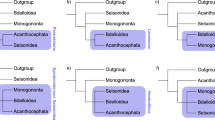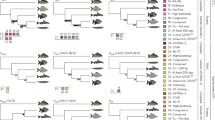Abstract
Recently there has been a lively debate about a new class of rare genomic characters, RGC_CAMs, and their implications for deep bilaterian phylogeny. Most recently, nine bilaterian species were analyzed along with subsets of six outgroups (Rogozin et al. 2007b), and support for a coelomate clade reported. The authors suggested that our previously reported support for an ecdysozoan clade (Irimia et al. 2007) reflected (i) one outgroup, Nematostella vectensis, being too closely related to bilaterians and (ii) lack of “rigorous statistical analysis.” Here, we report further studies of these characters. First, we discuss general issues of outgroup choice. Second, we point out that an argument used by Rogozin et al. against backmutation is not statistically significant. Third, we point out that the statistical method of Rogozin et al. fails to incorporate backmutations, leading to systematic placement of the long-branch taxon as the outgroup. A simple modification of the method yields very different results: 51 of 63 outgroup combinations favor Ecdysozoa, inlcuding 51 of 52 with at least eight phylogenetically informative characters, and all 19 with statistically significant signal. These results indicate that the Coelomata signal is a long-branch artifact.


Similar content being viewed by others

References
Aguinaldo AMA, Turbeville JM, Linford LS, Rivera MC, Garey JR, Raff RA, Lake JA (1997) Evidence for a clade of nematodes, arthropods and other moulting animals. Nature 387:489–493
Blair J, Ikeo K, Gojobori T, Hedges S (2002) The evolutionary position of nematodes. BMC Evol Biol 2:7
Delsuc F, Brinkmann H, Chourrout D, Philippe H (2006) Tunicates and not cephalochordates are the closest living relatives of vertebrates. Nature 439:965–968
Dopazo H, Dopazo J (2005) Genome-scale evidence of the nematode-arthropod clade. Genome Biol 6:R41
Field K, Olsen G, Lane D, Giovannoni S, Ghiselin M, Raff E, Pace N, Raff R (1988) Molecular phylogeny of the animal kingdom. Science 239:748–753
Irimia M, Maeso I, Penny D, Garcia-Fernandez J, Roy SW (2007) Rare coding sequence changes are consistent with Ecdysozoa, not Coelomata. Mol Biol Evol 24:1604–1607
Mushegian A, Garey J, Martin J, Liu L (1998) Large-scale taxonomic profiling of eukaryotic model organisms: a comparison of orthologous proteins encoded by the human, fly, nematode, and yeast genomes. Genome Res 8:590–598
Nguyen H, Yoshihama M, Kenmochi N (2005) New maximum likelihood estimators for eukaryotic intron evolution. PLoS Comput Biol 1:e79
Philip GK, Creevey CJ, McInerney JO (2005) The Opisthokonta and the Ecdysozoa may not be clades: stronger support for the grouping of plant and animal than for animal and fungi and stronger support for the Coelomata than Ecdysozoa. Mol Biol Evol 22:1175–1184
Philippe H, Lartillot N, Brinkmann H (2005) Multigene analyses of bilaterian animals corroborate the monophyly of Ecdysozoa, Lophotrochozoa, and Protostomia. Mol Biol Evol 22:1246–1253
Rogozin IB, Wolf YI, Carmel L, Koonin EV (2007a) Ecdysozoan clade rejected by genome-wide analysis of rare amino acid replacements. Mol Biol Evol 24:1080–1090
Rogozin IB, Wolf YI, Carmel L, Koonin EV (2007b) Analysis of rare amino acid replacements supports the Coelomata clade. Mol Biol Evol 24(12): 2594–2597
Rokas A, Holland PWH (2000) Rare genomic changes as a tool for phylogenetics. Trends Ecol Evol 15:454–459
Roy SW, Gilbert W (2005) Resolution of a deep animal divergence by the pattern of intron conservation. Proc Natl Acad Sci USA 102:4403–4408
Stuart G, Berry M (2004) An SVD-based comparison of nine whole eukaryotic genomes supports a coelomate rather than ecdysozoan lineage. BMC Bioinformatics 5:204
Wolf Y, Rogozin I, Koonin E (2004) Coelomata and not Ecdysozoa: evidence from genome-wide phylogenetic analysis. Genome Res 14:29–36
Zheng J, Rogozin IB, Koonin EV, Przytycka TM (2007) Support for the Coelomata clade of animals from a rigorous analysis of the pattern of intron conservation. Mol Biol Evol 24(11): 2583–2592
Author information
Authors and Affiliations
Corresponding author
Rights and permissions
About this article
Cite this article
Roy, S.W., Irimia, M. Rare Genomic Characters Do Not Support Coelomata: RGC_CAMs. J Mol Evol 66, 308–315 (2008). https://doi.org/10.1007/s00239-008-9077-5
Received:
Revised:
Accepted:
Published:
Issue Date:
DOI: https://doi.org/10.1007/s00239-008-9077-5



